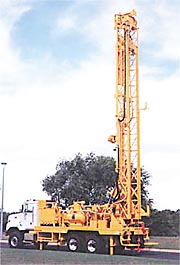
Contractor: Evans Energy Development Inc.
Client: Stonecroft Ministries, Kansas City, Mo.
Application: Geothermal Boreholes
Hammer: Numa Patriot 60
Hole size: 6 inches
Depth: 350 feet average
Formation: clay, limestone and shale
Rig type: Gefco Speedstar 30K
Project Profile
Drilling contractors throughout the years have been frustrated with the challenges presented by the harder rock formations. Today, with advances in drilling technology and methodology, drillers increasingly are turning to DTH hammers and bits in order to complete their more daunting projects.
One such drilling company that has realized significant success with DTH drilling is Evans Energy Development Inc. Evans is a Paola, Kan.-based drilling outfit with 21 years of experience in the energy industry and vast experience with drilling in all types of environments.
Recently, Evans utilized Numa’s Patriot 60 down hole hammer on a geothermal project in eastern Kansas. The Patriot 60 was supplied by NDS Drilling Supply of Elko, Minn. Because the drill crew was new to the DTH drilling method, Numa regional manager Kathy Wagoner went to the job site to provide training. Her presence allowed the drillers to ask questions and learn how to maximize the efficiencies of the system.
The project involved drilling geothermal boreholes to be used for a newly built Church ministry retreat camp for Stonecroft Ministries. The vertical heat loop will supply heating and hot water for the camp, which includes a 10,000-square-foot office and a two-story dorm with 41 apartments totaling 60,000 square feet. Forty holes were required for this project in ground conditions that consisted of clay, limestone and shale. Holes were drilled to a depth of 350 feet by a 2001 Gefco Speedstar 30K rig with a 1,000-cfm/ 350-psi onboard air compressor.
Geothermal is an emerging energy source that fuels advanced, energy-efficient heating and cooling systems that can provide savings up to 60 percent over conventional heating and cooling systems. It is environmentally friendly as it generates zero hazardous emissions. This helps to minimize many common problems such as acid rain, air pollution and the destruction of the ozone layer that typically are found in fossil fuel systems. The U.S. Environmental Protection Agency has endorsed this system as a viable alternative for heating and cooling homes and businesses. There even is legislation being reviewed that, if passed, will require geothermal heat loops in all government-financed building projects.
There are many different types of geothermal energy systems available today, and one of the most widely used is the closed loop system. The closed-loop system harnesses both the energy sources inside the earth and solar heat radiating down from the sun. These forces combine to provide a fairly constant temperature of 50 degrees F in the outer layer of the earth that is used in these energy systems. A geothermal heat loop system consists of series of pipes, a heat exchanger and ductwork that goes into the structure being heated and cooled. During the winter months, heat from the earth is collected in the exchanger and distributed into the structure. In the summer, the heat is absorbed from the air, and the water source carries the heat back to the earth in order to cool. The system also is very beneficial for heating water.
Numa’s Patriot 60 is a simplified hammer design that is accomplished by eliminating several internal components. Less overall parts makes the hammer easy to maintain, which means more time can be spent drilling. Also, the hammer is designed so that the feed tube attaches directly to the backhead of the hammer to provide proper alignment of all hammer parts. This results in longer hammer life and improved overall hammer performance.
From the outset of this project, the increase in drilling speed over previously used methods was obvious as the Evans crew had to alter its typical procedures. The crew now spent much of its time changing connections due to the increased drilling speed — 130 feet to 140 feet per hour. The drillers were able to complete an average of 1,000 feet per day, the equivalent of two to three holes. This virtually tripled the production Evans realized with its original drilling method, which would take up to three days to complete the same amount of holes now done in one.

Report Abusive Comment